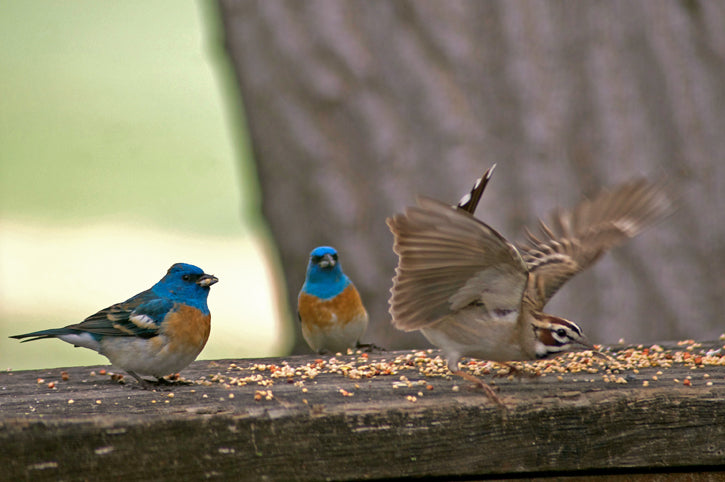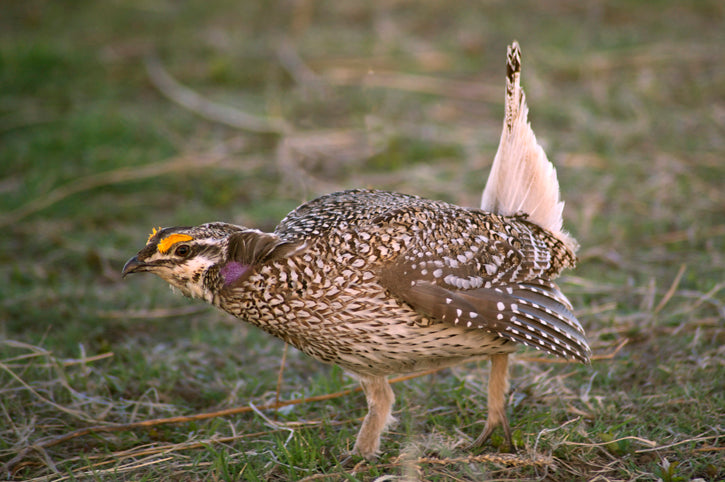Bird watching is a favorite pastime on the ranch and brings all of us so much joy.

The old cottonwoods that canopy the house are perfect for tree nesters and cavity dwellers.

These sites are carefully selected and are often out of sight. To see our feathered friends more clearly, we strategically place a couple of bird feeders off the deck of the ranch house for prime viewing.

Although a few bird species stay through the winter, most show up in the spring, raise their families, then bunch up in the fall and head south.
In addition to the fluttering above, there is a lot of action happening in the grasslands. Many of the species are shore birds, such as the Long Billed Curlew.

The ground-nesting birds are more challenging to view, as their plumage is subtler, like the prairie itself.
But like the passerines, many of these ground-nesting birds come to the prairie to breed and raise their young, with a few being year-long residents, like the Sharp Tailed Grouse.

Where birds live, and the habitat they need for their survival, is of great concern.
Each species seeks its specific niche within the prairie ecosystem. The diversity of the prairie grasses, or open arid areas, dotted with prairie playas, is the required habitat for many of these species.
There are currently over 200 species of ground-nesting birds on the Great Plains prairies. These grassland birds have been on the decline since the mid 1800’s.
When the European settlers arrived, an estimated 360 million acres of tall-grass, short-grass and mixed-grass prairies filled the middle part of our country. Today, about 70 million acres remain. Although there are many contributors to their decline, the loss of grassland habitat due to prairie plow up and other exploitation is the largest factor.
One of the most staggering statistics is the Eastern Meadowlark with an 89% decline over the last forty years. The Western Meadow Lark (pictured below) isn't trailing too far behind with a 40% decline over the same time period.
Their songs are the bugle call "that spring has arrived." To think of it being silenced is heart wrenching.
There is no doubt that preserving the breeding ground habitat for prairie ground-nesting birds is essential to their survival. So, if you see a lost or confused bird looking for good place to raise its family, send them our way, we've got room... as long as the buffalo keep roaming on.
Photos taken by Jill O'Brien on the Cheyenne River Ranch, in western SD.

23 comments
the fur… the fur of bison is what so many prairie birds need. Especially the ground nesters. In our 300 bison farm in southern Iowa it is the soft fur that makes up the bird nests. So many rare birds we have…all nesting on our high forb prairie. All using the fur to line their nests. It is the fur of the buffalo one never thinks of… My brother studied the small mammals of our bison pastures.. compared to cattle pastures right across the fence. Same composition of forage. Same height. But on our fur littered grounds 10 times the amount of mice. My brother would even see mice running in broad daylight, risking death by hawks, running to fur tuffs across big bare roll spots to gather fur for their nests. And squirrels all gathering fur for their nests in the trees. And with lots more small mammals it means we have a lot more coyotes and foxes. than our furless neighbors cattle farms. It is all of the tropic cascade effect not understood. This is what bison and their fur did to our original prairies… and now isolated to small lands like ours and Wild Ideas bison herds. Oh, so much has been lot. The birds of the prairie… so much dependent on that fur.
A friend posted these photos with the link to you. You have a gorgeous place and wonderful birds there. Do you ever have birdwatching tours or events there? If so, I’d love to know about it!
Thank you for all that you do.
Beautiful photos. I love bird watching also.
Thanks so much for this post. I will be moving to OK in September and was wondering what species of birds I would be able to see. These are such colorful and exciting birds. Hummingbirds just came to my feeders in Virginia this week. Do you have hummingbirds our where your are?
Wonderful bird photos and narritive Jill. Thank you.
Thank you. I live in California, but have very fond memories of bird watching on the Southwestern Minnesota prairie with my grandfather.
Fantastic photos, Jill! Thanks for sharing!
Very pleased to see the rare birds, most folks in Washington don’t realize how important these creatures are and all of our help is needed to help these birds trive again
Thanks for sharing these wonderful photographs and information, Jill. How neat to live on a prairie and see such a variety
of birds.
Thank you, Jill great photos and descriptions. Hope I will one day be able to see them in person. Take care and love to all.
The photos you display are priceless! How blessed you are to live in that special place.
So far, these photographs have been the highlight of my day – quite possibly week. You have a real gift for capturing the nuances of these birds personalities. Beautiful. I’m going to forward this on, to friends near Sedona, who have a bird sanctuary, on their Canyon Wren property. Thank you, for the poetry, in pictures.
Good story and good photos keep up the good work. May God bless you and yours.
Thanks Jill….splendid!
Beautiful! Thanks for sharing.